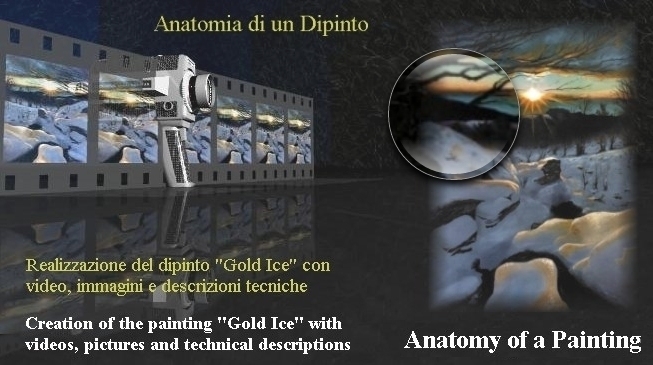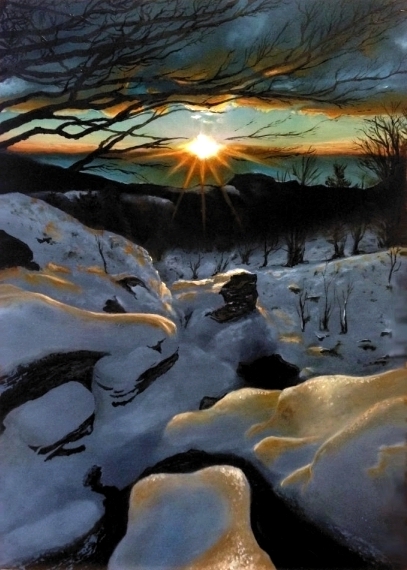

In questo trattato dedicato alla realizzazione del dipinto Gold Ice olio su tavola di dimensioni 25x35 cm, analizzeremo in maniera accurata tutti i vari passaggi relativi alla tecnica di esecuzione in maniera chiara con video , foto e descrizioni . Il dipinto in analisi raffigurante un paesaggio invernale , è stato eseguito secondo la tecnica usata dalla antica Scuola Napoletana, nonchè unita a quest'ultima, la mia esperienza artistica strettamente personale . Spero di comunicare a coloro che con interesse si avvicinano a questo genere di pittura, il miglior contributo, con l'auspicio di rimanere in ognuno una esperienza valida e costruttiva che sicuramente aiuterà nel percorso soggettivo di coloro che con passione conseguono la strada della pittura. Fatta questa piccola premessa, vediamo da qui in seguito tutte le fasi dimostrative per la realizzazione del dipinto, munitevi di buona pazienza e buon lavoro......
In this treatise dedicated to the creation of Ice Gold painted oil on canvas size 25x35 cm, we'll analyze accurately all the various steps involved in running technique clearly with videos, photos and descriptions. The painting depicting a winter landscape analysis was performed according to the technique used by the ancient Neapolitan School, as well as united to the latter, my strictly personal artistic experience. I hope to communicate to those with interest close to this kind of painting, the best contribution, in the hope of staying in each one a good and constructive experience that will surely help you in the path of those who passionately subjective achieve the way of painting. After this short introduction, we can see from henceforth all stages demonstration for the creation of the painting, equip yourself with good patience and good work
questo è il nostro dipinto da realizzare
this is our painting to be carried out







Partiamo da una tavoletta di legno , generalmente uso legno multistrato di spessore di mm14-18 , uso questo tipo di legno in quanto è meno soggetto nel tempo alla deformazione, in questo caso ho preferito una tavoletta rivestita di laminato plastico al fine di rendere il supporto perfettamente liscio, dopo averla pulita per bene , ho applicato il colore, che come possiamo vedere in foto si presenta nero , ma in realtà è un nero con una parte (solitamente 1/4) di terra di Siena bruciata per un motivo molto semplice, ovvero, per dar modo successivamente all'eventuale colore nero assoluto di evidenziarsi comunque. Quando applicherete il colore di fondo (almeno 2 mani ), prestate attenzione nell'ultima stesura di non rimanere solchi di pennello , consiglio di "accarezzare" il colore con un pennello tipico per velatura denominato "ventaglio" . Per una maggiore rapidità di essiccazione usate essiccativo al cobalto , per la diluizione dei colori l'olio di papavero, un po' più costoso ma efficiente per mantenere intatto il tono dei colori chiari in quanto quello di lino tende ad ingiallire nel tempo.
We start from a wood tablet, generally I use plywood
thickness of mm 14 -18 , I use this type of wood because it's less subject
to deformation over time , in this case I preferred a tablet coated with
plastic laminate in order to make the support perfectly smooth after it has
been cleaned thoroughly, I applied the color, which as we can see in the
photo looks black, but in reality it is a black with a portion (usually 1/4)
of burnt Siena for a verysimple reason , or , to give a way that
subsequently to the possible absolute black color to stand out anyway. When
you'll apply the background color (at least 2 hands ) , be careful not to
get the last draft of the grooves of the brush, I advice to you to " caress
" the color with a brush for a typical haze called "fan" . For a faster
drying cobalt drier use for the dilution of the colors "oil poppy" , it's a
bit more expensive but it's more efficient to maintain the tone of light
colors as that of flax tends to yellow over time.


Dopo atteso che il fondo sia bene asciutto, passiamo alla prima fase del dipinto, iniziando dal cielo compreso le sue sfumature di fondo, ovviamente prima di iniziare il dipinto , è buona norma "osservare" l'immagine da dipingere, io a volte lo faccio per ore, ovvero per giorni interi analizzo attentamente la strategia di esecuzione del dipinto, ossia, quali zone dipingere per primo e come ottenere risultati di colori sfumati, velati ecc... Questo e' molto importante per un buon esito di un'opera , quindi consiglio per prima cosa di analizzare bene i colori aiutandovi con un software di grafica, io uso Corel Photo Paint vers. 7 con cui adoperando lo strumento "contagocce" estrapolo il campione di colore che mi interessa e la sua composizione ( solitamente in RGB ) . Questo e' molto importante perché non sempre ciò che vediamo è legittimo al colore che si crede di osservare, per esempio , il colore della neve del dipinto in questione è praticamente grigio con un pizzico di blu, ma i nostri occhi , di primo approccio lo formalizzano come un bianco. Questo succede per vari motivi , ed è giusto così , in quanto il colore varia a seconda della luce che riceve e dal contesto in cui si trova relativamente agl'altri colori che lo circondano. Per apprendere bene questo concetto , provate a fare un quadrato di un qualsiasi colore prima su fondo bianco e poi su nero , vedrete che nell'osservare alternando gli occhi su entrambi, il colore che ha il fondo nero vi apparirà più chiaro di quello affianco che in realtà è lo stesso colore.
After expected that the bottom is dry , we pass the
first stage of painting , starting with the sky background including its
nuances , of course, before you start painting , it is a good idea to "observe
" the image of painting, I sometimes do it for manny hours or for days
carefully I analyze the implementation strategy of the painting, that's,
which areas to paint and how to get results for the first gradient color ,
veiled, and so on ... This is very important for a successful outcome of a
work , so I recommend to you first analyze the colors well with the aid of a
graphics software , I use Corel Photo Paint vers . 7 striving with which the
tool " eyedropper " I extrapolate the color swatch that interests me and its
composition (usually in RGB). This is very important because what we see is
not always legitimate to the color that is believed to be observed , for
example, the color of the snow of the painting in question is basically gray
with a hint of blue, but our eyes , to the first approach we formalize as a
white color. That happens for various reasons , and rightly so ,because the
color changes depending the light that receives and from the context in
which it is relatively located to the others colors that surround it. To
know this concept , try to draw a square of any color before on white and
then black , you we'll see that observing them alternating on both eyes ,
the color that has the black background it will appear to you lighter of
that next , that actually it's the same color .

Iniziamo a dipingere il cielo fino all'orizzonte coi colori blu di Prussia, verde smeraldo e un po' di lacca di garanza, notate nel video la linea alta delle montagne che opportunamente ho tracciato prima usando un colore qualsiasi chiaro giusto per intravederla , cio' serve per proporzionare la sfumatura di ocra gialla e giallo cadmio arancio che e' all'orizzonte. Le montagne sono dello stesso colore del cielo ma sostanzialmente molto piu' scuro. Con il pennello a ventaglio sfumate i colori affinchè diventino uniformi e gradualmente varianti nei toni.
We begin to paint the sky to the horizon with the colors of Prussian blue, emerald green and a bit 'of madder lake, we can notice in the video the high line of the mountains which I traced properly before using any color light just to glimpse it, that' serves to proportion the shade of yellow ocher and orange cadmium yellow that's to the horizon. The mountains are the same color as the sky, but substantially much darker. With the fan brush soft thecolors for you to become uniform and gradually variations in shades.